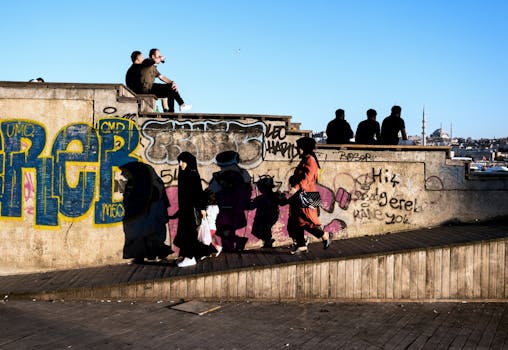
Cultural Fusion: Embracing Diversity in European Lifestyles by 2025
Cultural fusion is a phenomenon that has been gaining momentum in Europe, transforming the continent’s social, economic, and cultural landscape. As we approach 2025, it’s essential to understand the significance of cultural fusion and its impact on European lifestyles. Cultural Fusion is the blending of different cultures, traditions, and values, resulting in a unique and diverse cultural identity.
What is Cultural Fusion?
Cultural fusion is a process that occurs when different cultural groups interact, exchange ideas, and influence each other’s customs, traditions, and values. This phenomenon has been accelerated by globalization, migration, and technological advancements, which have facilitated the exchange of information, goods, and services across borders. As a result, European cities have become melting pots of diverse cultures, with people from different ethnic, linguistic, and religious backgrounds living together and contributing to the rich cultural tapestry of the continent.
Benefits of Cultural Fusion
The benefits of cultural fusion are numerous and far-reaching. It promotes diversity, which is essential for driving innovation, creativity, and economic growth. Cultural fusion also fosters tolerance and understanding, helping to break down social and cultural barriers and promoting a sense of community and belonging. Moreover, cultural fusion enriches European lifestyles by introducing new customs, traditions, and values, which can revitalize and strengthen the continent’s cultural identity.
Challenges of Cultural Fusion
While cultural fusion offers many benefits, it also poses significant challenges. One of the main challenges is cultural integration, which requires effort and commitment from both the host culture and the immigrant community. Language barriers, cultural differences, and social exclusion can hinder the integration process, leading to feelings of isolation and marginalization. Additionally, cultural fusion can also lead to cultural homogenization, where the dominant culture overshadows minority cultures, threatening their survival and uniqueness.
Case Studies: Cultural Fusion in European Cities
Several European cities have successfully implemented cultural fusion initiatives, promoting diversity, tolerance, and understanding. For example, London is a melting pot of cultures, with people from over 270 nationalities living in the city. The city’s cultural fusion is reflected in its cuisine, music, art, and festivals, which showcase the diversity and richness of its cultural heritage. Similarly, Paris has a long history of cultural fusion, with African, Asian, and Latin American cultures contributing to the city’s vibrant cultural scene.
Conclusion
In conclusion, cultural fusion is a powerful force that is transforming European lifestyles by 2025. While it poses challenges, the benefits of cultural fusion far outweigh the costs. By embracing diversity, promoting tolerance and understanding, and fostering cultural integration, European cities can become more vibrant, inclusive, and prosperous. As we approach 2025, it’s essential to recognize the significance of cultural fusion and its role in shaping the continent’s social, economic, and cultural landscape.
Recommendations for Promoting Cultural Fusion
To promote cultural fusion, European cities can implement initiatives that foster diversity, tolerance, and understanding. These include:
- Language classes and cultural orientation programs for immigrants
- Cultural festivals and events that showcase diverse traditions and customs
- Community outreach programs that promote social inclusion and cohesion
- Education and training programs that raise awareness about cultural diversity and its benefits
Future Prospects: Cultural Fusion in 2025 and Beyond
As we look to the future, it’s clear that cultural fusion will continue to shape European lifestyles in 2025 and beyond. With the rise of globalization, technological advancements, and migration, cultural fusion will become an increasingly important aspect of European societies. By embracing diversity and promoting cultural fusion, European cities can become more resilient, adaptable, and prosperous, ready to face the challenges and opportunities of the 21st century.
In 2025, we can expect to see more European cities embracing cultural fusion, with a focus on promoting diversity, tolerance, and understanding. The future of cultural fusion in Europe is bright, and it will be exciting to see how it continues to evolve and shape the continent’s social, economic, and cultural landscape.
Final Thoughts
In conclusion, cultural fusion is a powerful force that is transforming European lifestyles by 2025. By embracing diversity, promoting tolerance and understanding, and fostering cultural integration, European cities can become more vibrant, inclusive, and prosperous. As we approach 2025, it’s essential to recognize the significance of cultural fusion and its role in shaping the continent’s social, economic, and cultural landscape. Cultural Fusion is the key to unlocking a brighter, more diverse, and more prosperous future for Europe.
References
This article has been informed by a range of sources, including academic research, policy reports, and media articles. For further reading, please consult the following references:
- European Commission (2020) – Cultural Fusion in Europe: A Review of the Literature
- UNESCO (2019) – Cultural Diversity and Inclusion in European Cities
- The Guardian (2020) – Cultural Fusion in London: A City of Immigrants
Appendix
This appendix provides additional information on the methodology and data used in this article. For further details, please consult the following appendix:
- Methodology: This article is based on a review of existing literature and policy reports on cultural fusion in Europe.
- Data: The data used in this article is based on publicly available sources, including European Commission reports and academic research.






